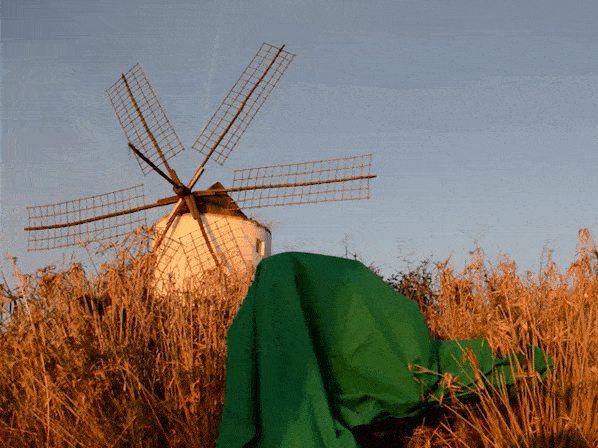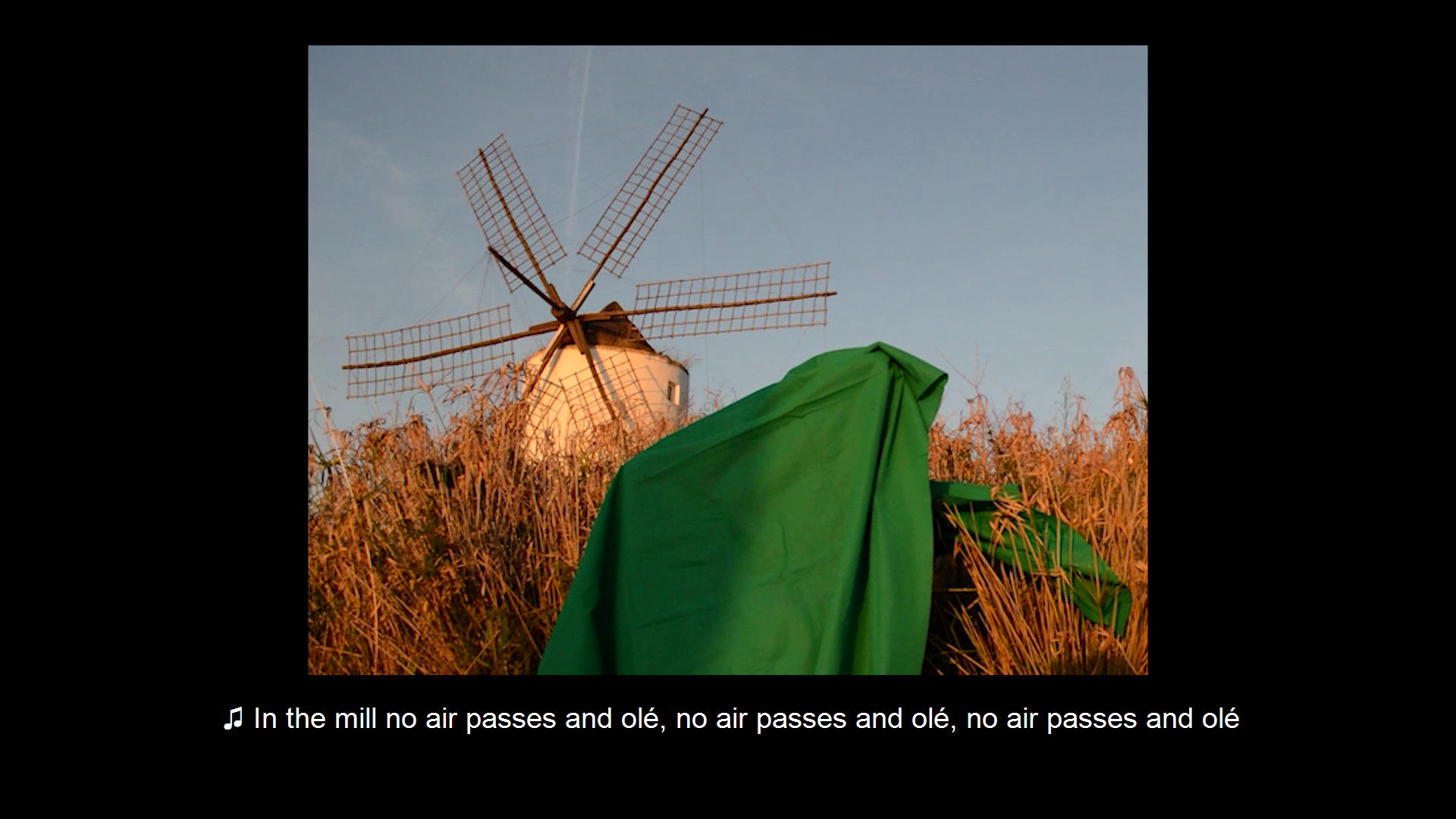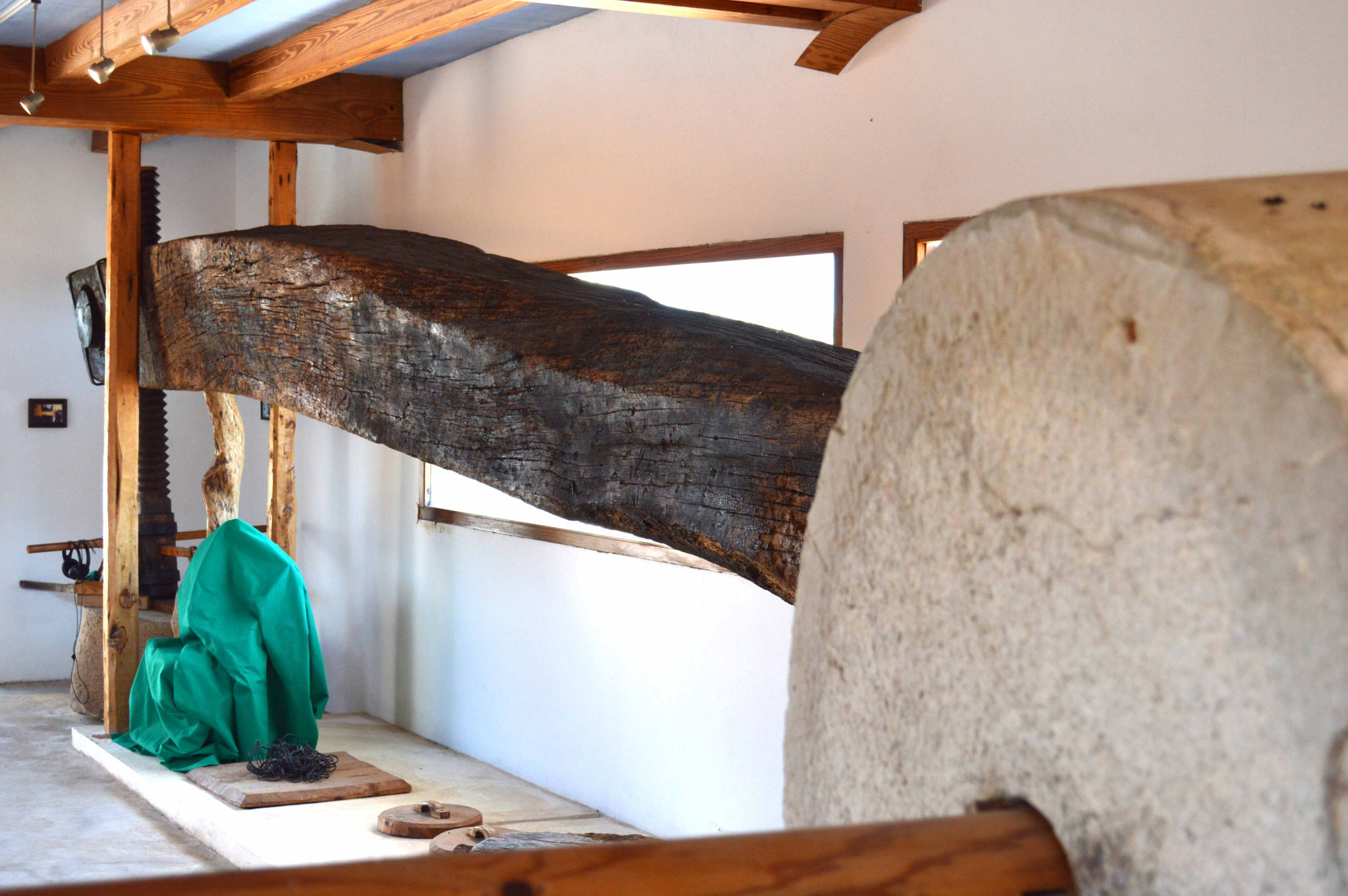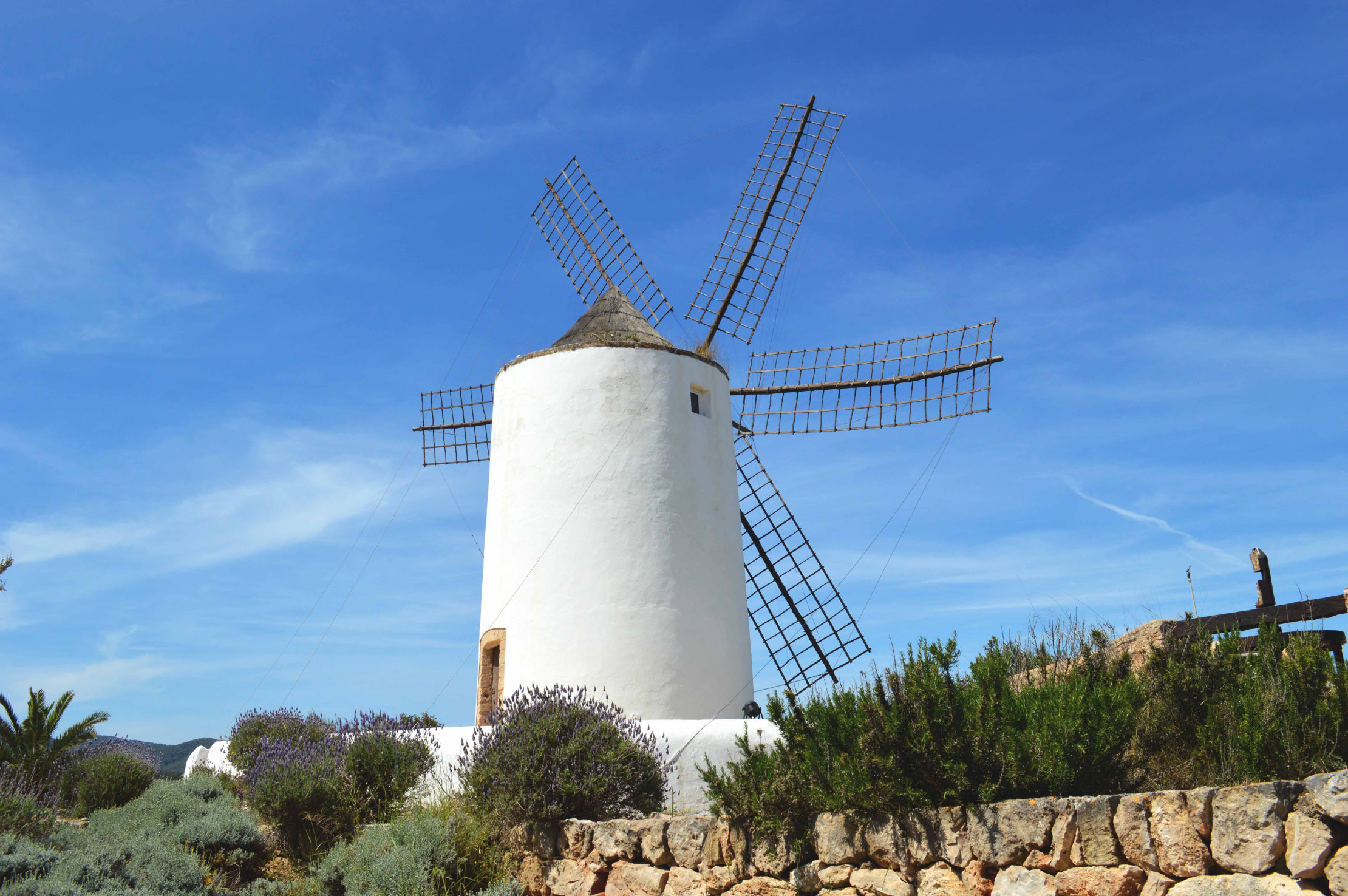ES
Poética al Resguardo: del Polvo y el Aire, mi Abuela y un Molino, 2023. Vídeo, fotografía digital, sonido, instalación.
Entre cantos populares sobre molinos, el pensar en mi hogar, la comunicación desde la distancia y el sentir migrante, el concepto de una postal física sé multi diversa. La postal escrita, con imágenes, imagen en movimiento o con un mensaje de voz, como lo que tenemos en la contemporaneidad, nos amplían las posibilidades de seguir habitando nuestras memorias y recuerdos. Se habla de la desaparición de la colección de postales de Walter Benjamín, entre ellas con las que se permitía habitar aquellos paisajes que su abuela viajera le enviaba desde su transitar por el mundo. Probablemente, ha sucedido lo mismo con mi abuela en Venezuela al ver fotografías mías con la nieve en Alemania y que les compartí desde la distancia por mensajería instantánea desde mi teléfono celular. Sin embargo, esa capacidad de habitar también es posible desde los cuentos que narran la gente, a veces cantados en coplas tradicionales y que, al igual que una fotografía, un dibujo o una pintura, nos transmiten imágenes a nuestro imaginario.
El elemento molino se usaba a menudo para describir literal o figurativamente textos ficticios de la sabiduría popular y de la historia del desarrollo de una nación. Abundan los refranes, adivinanzas y canciones, que ahora sobreviven en textos impresos y algunas grabaciones de audio con distintos fragmentos que se pueden encontrar en la web. Muchas canciones nos hablan de molinos, molinero, molinera, viento, trigo, maíz y piedras. Es obvia la importancia que tenían los molinos como lugar integrante de la vida cotidiana, e incluso la vida pasada en una sociedad donde todos iban a conseguir algo simple como pan. ¿Qué tanto nos puede retratar, narrar o evocar una postal del antiguo molino de Buenavista, en Sa Punta des Molí (1818) de Ibiza? ¿Es acaso su existencia un mito a su propia aura? ¿Son las aspas del molino un mito de la temporalidad de la vida global? Algo así como cuando todo inicia y retorna a su punto de comienzo. Como la migración de mi abuela canaria a Venezuela en la década de los cincuenta debido a las graves dificultades económicas que atravesaba España desde finales de los años cuarenta, y en la actualidad, el giro migratorio de sus descendientes a su punto de origen, como yo, que he migrado de Venezuela a Europa mientras suceden otras olas migratorias hacia otras partes del mundo en pleno siglo XXI.
“Existe una cita secreta entre las generaciones que fueron y la nuestra”. “La verdadera imagen del pasado transcurre rápidamente. Al pasado sólo puede retenérsele en cuanto imagen que relampaguea, para nunca más ser vista, en el instante de su cognoscibilidad”.
Fragmentos de las tesis 2 y 5 de filosofía de la historia, Walter Benjamin, 1940.
–
"Poética al Resguardo: Del Polvo y el Aire, mi Abuela y un Molino" es una instalación multimedia presentada en la primera edición del festival de arte "ENTRÁSITO" en el Espacio Cultural de Sa Punta des Molí, Sant Antoni, Ibiza, España (2023). Hogar temporal y refugio del escritor alemán Walter Benjamin durante los años de su emigración durante la persecución nazi (1939). El carácter migratorio del espacio se fusionó con el carácter transitorio de esta exposición, otorgando temporalidad a mis reflexiones sobre ser residente o migrante, viajero o refugiado, en un entorno natural industrializado.
Aproveché la ocasión para construir una intervención híbrida en la que a través de actuaciones de video/foto, montaje y paisaje sonoro, construí nuevas narrativas del concepto clásico de las postales a través de conexiones poéticas entre mensajes de voz de mi abuela española en Venezuela y desde donde se mantuvo en comunicación conmigo desde lejos, desde que me mudé a Alemania. Una oda a la famosa colección de postales perdidas de la abuela de Benjamin, así como un enfoque simbólico en las viejas canciones populares sobre molinos y el Molino de Buenavista en Punta des Molí.
–
Paisaje sonoro
https://soundcloud.com/arnaldogonzalezvisual/del-polvo-y-el-aire-mi-abuela-y-un-molino
(Descripción)
Se escucha el viento, y quizá, en la cercanía, unas olas del mar también, mientras un grupo de mujeres intentan recordar y cantar una copla sobre un molino:
En el molino, no pasa un aire y olé, no pasa un aire y olé, no pasa un aire y olé.
Alguien del grupo les rectifica: ¿se repite o no se repite?
El grupo inicia de nuevo: Amasa el polvo y la arena
Se le vuelve a rectificar: ¡la harina es!
El grupo vuelve a cantar:
Amasa el polvo y la harina que lleva el aire, y olé, que lleva el aire, y olé, que lleva el aire, y olé, y olé, que lleva el aire.
Aparece una cantora:
Porque dice el molinero, no tiene quien le acompañe, vente conmigo al molino y serás mi molinera. Echarás trigo a la tolva, echarás trigo a la tolva, mientras que pico a piedra, vente conmigo al molino y serás mi molinera.
Aparece un mensaje de voz de mi abuela desde Venezuela:
¡Hola! ¿Mucha nieve mi amor, mucha nieve? Cónchale, ¡tengan cuidado! ¡Que te enfrías! ¿Sabes? Oye, oye Arnaldo, con la nieve y ahí tomándote una tacita de café bien caliente, cómo será eso mi amor, ¿verdad? ¡Chévere!
Mira, me dio sentimiento, yo no sé cuantas semanas hacía que no veía a tu hermano, sí, pero tiene que cumplir con sus obligaciones mi amor. Pues bueno mi amor, que Dios te bendiga. ¡Un abrazo fuerte, fuerte! Bueno, pues, ¡Y un besote! Échale un abrazo a tu hermana, que se lo mando yo. ¿Oíste? OK. Que Dios me los bendiga.
Se unen otras voces de mujeres cantando:
Molinero, molinero, solo sabe mi molino, lo mucho que yo te quiero ¡Ay mi molinero! Y en el feliz momento donde se agitan las aspas del molino, allí se oyó un lamento de un beso divino, del maíz y del trigo tan divino. Molinero, molinero, solo sabe mi molino, lo mucho que yo te quiero ¡Ay mi molinero! Cantando y bailando y pensando en mi pobre molinero, la vida voy pasando sin otro compañero, del maíz y del trigo placentero. Molinero, molinero, solo sabe mi molino, lo mucho que yo te quiero ¡Ay mi molinero!
Coplas / Couplets: Coplas del molino (1983), Vente conmigo al molino (2010), Molinero solo sabes tu molino (1984).
Fundación Joaquín Díaz, España. kindly provided this file by means of Wikimedia Spain.
Licensed under the Creative Commons Attribution-Share Alike 3.0 Unported.
Mensaje de voz de Maria Luisa Gamez de González (2023). Montaje digital por Arnaldo Drés González.
–
"Del Polvo y el Aire, mi Abuela y un Molino" forma parte de mi proyecto "Resguardo y Presencia" donde traduzco el aspecto estético y la funcionalidad protectora de las telas verdes que cubren las fachadas de edificios en desintegración en ciudades y espacios rurales del mundo en narrativas poéticas personales que mezclan la intervención del cuerpo humano y sus posibles conexiones con la identidad, la protección y el territorio. El proyecto explora cómo personas de distintos orígenes culturales y geográficos vinculan la realidad y la metáfora de una figura, personaje u objeto que se transforma en un mismo lugar y crea tiempo y espacio para definir con calma lo que vemos. Los espectadores experimentan vivencias contemplativas a través del vídeo, la fotografía, la instalación y la performance de las que finalmente surge una nueva imagen individual en el ojo del espectador.
DE
Poetik im Schutzraum: von Staub und Luft, meiner Großmutter und einer Windmühle, 2023. Video, Digitalfotografie, Ton, Installation.
Zwischen populären Liedern über Windmühlen, dem Nachdenken über die Heimat, der Kommunikation aus der Ferne und dem Gefühl des Migranten ist das Konzept der physischen Postkarte sehr vielfältig. Die geschriebene Postkarte, mit Bildern, bewegten Bildern oder mit einer Sprachnachricht, wie wir sie in der heutigen Zeit haben, erweitert die Möglichkeiten, unsere Erinnerungen und Rückblicke zu bewohnen. Man spricht davon, dass Walter Benjamins Postkartensammlung verschwunden ist, darunter auch jene, mit denen er sich die Landschaften, die ihm seine reisende Großmutter von ihren Reisen um die Welt schickte, bewohnen ließ. Wahrscheinlich ist meiner Großmutter in Venezuela dasselbe passiert, als sie Fotos von mir im Schnee in Deutschland sah, die ich ihr aus der Ferne per Instant Messaging von meinem Mobiltelefon aus mitteilte. Diese Fähigkeit zum Bewohnen ist jedoch auch durch die von Menschen erzählten Geschichten möglich, die manchmal in traditionellen Liedern gesungen werden und die, wie eine Fotografie, eine Zeichnung oder ein Gemälde, Bilder an unsere Vorstellungskraft weitergeben.
Das Element des Mühlsteins wurde oft verwendet, um buchstäblich oder bildlich fiktive Texte der Volksweisheit und der Entwicklungsgeschichte einer Nation zu beschreiben. Es gibt zahlreiche Sprichwörter, Rätsel und Lieder, die heute in gedruckten Texten und einigen Tonaufnahmen mit verschiedenen Fragmenten, die im Internet zu finden sind, überleben. In vielen Liedern ist von Mühlen, Müllern, Wind, Weizen, Korn und Steinen die Rede. Es ist offensichtlich, wie wichtig Mühlen als fester Bestandteil des Alltags und sogar des vergangenen Lebens in einer Gesellschaft waren, in der jeder hinging, um etwas Einfaches wie Brot zu bekommen. Wie viel kann eine Postkarte der alten Mühle Buenavista in Sa Punta des Molí (1818) auf Ibiza darstellen, erzählen oder evozieren? Ist ihre Existenz ein Mythos ihrer eigenen Aura? Sind die Klingen der Mühle ein Mythos der Zeitlichkeit des globalen Lebens? So, wie wenn alles beginnt und zu seinem Ausgangspunkt zurückkehrt. Wie die Migration meiner kanarischen Großmutter nach Venezuela in den 1950er Jahren aufgrund der ernsten wirtschaftlichen Schwierigkeiten, die Spanien seit den späten 1940er Jahren erlebte, und heute die Rückwanderung ihrer Nachkommen an ihren Ursprungsort, so wie ich, die von Venezuela nach Europa migriert sind, während andere Migrationswellen in andere Teile der Welt im 21.
„Es gibt eine geheime Übereinkunft zwischen den vergangenen Generationen und der jetzigen”. "Das wahre Bild der Vergangenheit fliegt vorbei. Die Vergangenheit kann nur als ein Bild erfasst werden, das in dem Augenblick aufblitzt, in dem es erkannt werden kann, und nie wieder gesehen wird".
Fragmente der Thesen 2 und 5 zur Philosophie der Geschichte, Walter Benjamin, 1940.
–
From Dust and Air, my Grandmother and a Windmill (Aus Staub und Luft, meiner Großmutter und einer Windmühle) ist eine multimediale Installation, die auf der ersten Ausgabe des Kunstfestivals "ENTRÁSITO" im Kulturraum von Sa Punta des Molí, Sant Antoni, Ibiza, Spanien (2023) präsentiert wurde. Vorübergehendes Zuhause und Zufluchtsort des deutschen Schriftstellers Walter Benjamin während seiner Emigration während der Nazi-Verfolgung (1939). Der wandernde Charakter des Raumes verschmolz mit dem flüchtigen Charakter dieser Ausstellung und verlieh meinen Reflexionen über das Leben als Bewohner oder Migrant, Reisender oder Flüchtling in einer industrialisierten Naturlandschaft Zeitlichkeit.
Ich nutzte die Gelegenheit, um eine hybride Intervention zu schaffen, bei der ich durch Video-/Foto-Performances, Assemblage und Klanglandschaft neue Erzählungen des klassischen Konzepts von Postkarten durch poetische Verbindungen zwischen Sprachnachrichten meiner spanischen Großmutter aus Venezuela und dem Ort, von dem aus sie aus der Ferne mit mir kommunizierte, seitdem ich nach Deutschland gezogen bin, konstruierte. Eine Ode an Benjamins berühmte Sammlung verlorener Postkarten seiner Großmutter sowie ein symbolischer Zugang zu alten Volksliedern über Mühlen und die Buenavista-Mühle an der Punta des Molí.
–
Klanglandschaft
https://soundcloud.com/arnaldogonzalezvisual/del-polvo-y-el-aire-mi-abuela-y-un-molino
(Beschreibung der Klanglandschaft)
Übersetzung aus dem Spanischen (Original) ins Englische
Der Wind ist zu hören und vielleicht ein paar Wellen vom Meer, während eine Gruppe von Frauen versucht, sich daran zu erinnern, ein Couplet über eine Mühle zu singen:
In der Mühle geht keine Luft und olé, keine Luft geht und olé, keine Luft geht und olé.
Jemand aus der Gruppe korrigiert sie: Soll das wiederholt werden oder nicht?
Sie singen noch einmal: Knetet den Staub und den Sand
Eine neue Korrektur: ist Mehl!
Sie beginnen erneut:
Knetet den Staub und das Mehl, das die Luft trägt und olé, das die Luft trägt und olé, das die Luft trägt und olé, olé, das die Luft trägt.
Eine Sängerin tritt auf:
Weil der Müller sagt, dass er niemanden hat, der mit ihm geht, komm mit mir zur Mühle und du wirst meine Müllerin sein. Du wirfst den Weizen in den Trichter, du wirfst den Weizen in den Trichter, während ich den Stein pflücke, komm mit mir zur Mühle und du wirst meine Müllerin sein.
Es erscheint eine Sprachnachricht von meiner Großmutter aus Venezuela:
Hallo! Eine Menge Schnee, meine Liebe, eine Menge Schnee? Oh, sei vorsichtig! Du wirst dich erkälten, weißt du. Hey Arnaldo, wie wird das sein, mein Schatz, dort mit dem Schnee und dann eine Tasse heißen Kaffee trinken, nicht wahr? Ja, sehr gut.
Sieh mal, das hat mich aufgeregt. Ich weiß nicht, wie viele Wochen ich deinen Bruder schon nicht mehr gesehen habe, aber er muss seinen Verpflichtungen nachkommen. Nun, meine Liebe, Gott segne dich, eine dicke, dicke Umarmung! Und einen dicken Kuss! Bitte umarme deine Schwester von mir, ich schicke sie zu ihr. Hast du es bekommen? O.K. Gott segne dich.
Andere Frauenstimmen stimmen in den Gesang ein:
Müller, Müller, nur meine Mühle weiß, wie sehr ich dich liebe, oh mein Müller! Und in dem glücklichen Moment, in dem sich die Mühlenflügel bewegen, ertönt die Klage über einen göttlichen Kuss, über Korn und Weizen, die so göttlich sind. Müller, Müller, nur meine Mühle weiß, wie sehr ich dich liebe, oh mein Müller! Singend und tanzend und an meinen armen Müller denkend, gehe ich durch das Leben ohne einen anderen Partner, von Korn und angenehmem Weizen. Müller, Müller, nur mein Müller weiß, wie sehr ich dich liebe, oh mein Müller!
Couplets: Coplas del molino (1983), Vente conmigo al molino (2010), Molinero solo sabes tu molino (1984).
Fundación Joaquín Díaz, Spanien. Diese Datei wurde freundlicherweise von Wikimedia Spanien zur Verfügung gestellt.
Lizensiert unter der Creative Commons Attribution-Share Alike 3.0 Unported.
Sprachnachricht von Maria Luisa Gamez de González (2023). Digital zusammengestellt von Arnaldo Drés González.
–
From Dust and Air, my Grandmother and a Windmill (Aus Staub und Luft, meiner Großmutter und einer Windmühle) ist Teil meines Projekts „Shelter and Presence”, in dem ich den ästhetischen Aspekt und die schützende Funktionalität der grünen Stoffe, die die Fassaden zerfallender Gebäude in Städten und ländlichen Gebieten auf der ganzen Welt bedecken, in persönliche poetische Erzählungen übersetze, die die Intervention des menschlichen Körpers und seine möglichen Verbindungen zu Identität, Schutz und Territorium miteinander verbinden. Das Projekt untersucht, wie Menschen mit unterschiedlichem kulturellem und geografischem Hintergrund die Realität und die Metapher einer Figur, eines Charakters oder eines Objekts miteinander verbinden, das sich an einem Ort verwandelt und Zeit und Raum schafft, um in aller Ruhe zu definieren, was wir sehen. Die Betrachter machen durch Video, Fotografie, Installation und Performance kontemplative Erfahrungen, aus denen schließlich ein neues, individuelles Bild im Auge des Betrachters entsteht.






